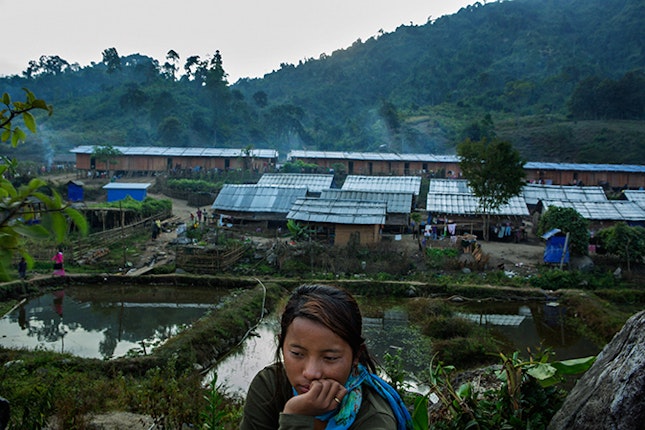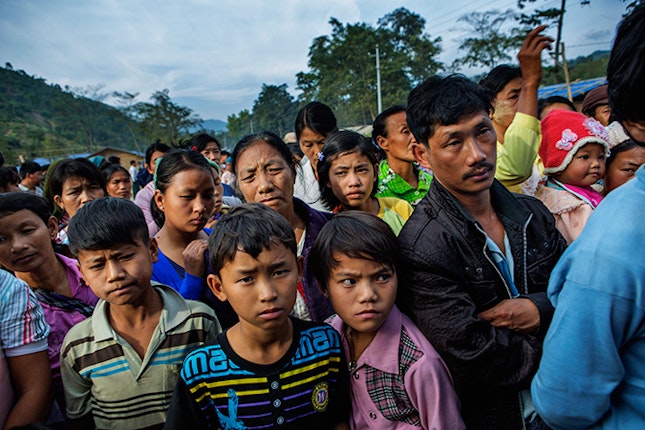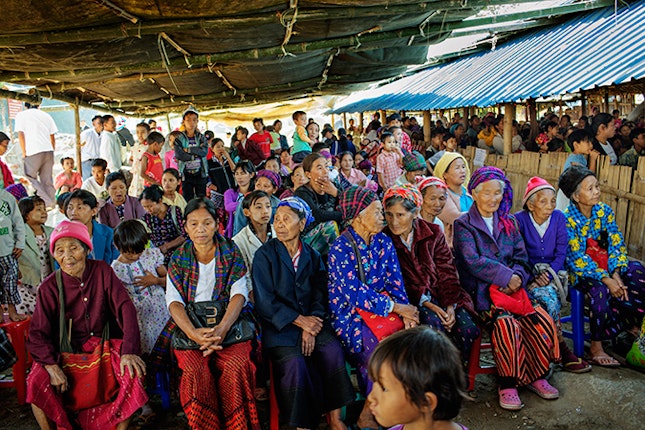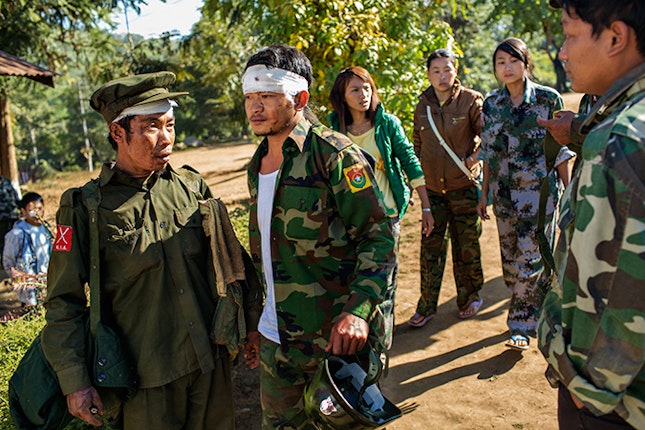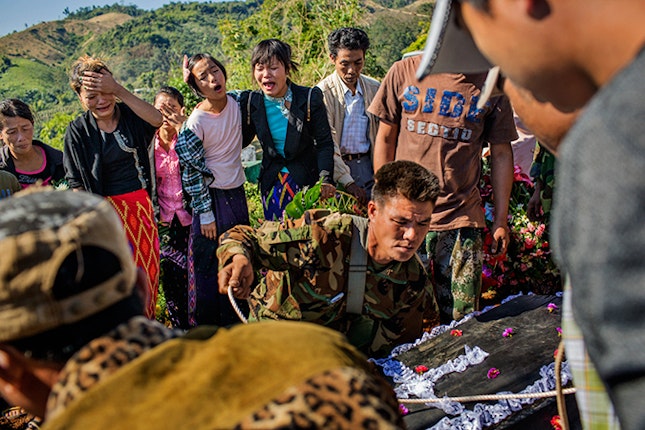Women, Violence, and Burma: Reporting from the Frontlines in Kachin State
By Zaynab Nawaz & Meghan O’Connor
In November 2010, Burma transitioned from five decades of authoritarian rule to a semi-civilian government with the election of President Thein Sein and a new parliament. Signaling a shift towards democracy, President Thein Sein initiated political, economic, and social reforms including the release of thousands of political prisoners; the peaceful election of opposition leader Daw Aung San Suu Kyi and 42 of her National League for Democracy colleagues to Parliament in April 2012; and the re-commitment to peace negotiations with ethnic groups with whom the Burmese military has been mired in conflict for over fifty years.
Despite these positive developments, human rights violations and armed conflict in the country continue, particularly in the resource rich and historically marginalized ethnic regions of Eastern Burma.
Kachin State and Northern Shan State have seen an escalation of conflict and human rights abuses since June 2011. Ongoing fighting and intermittent intensive military strikes between the Burmese military and the Kachin Independence Army (the military arm of the Kachin Independence Organization) have resulted in the displacement of 100,000 people; there is limited to no humanitarian access for these displaced communities which are primarily composed of women, children, and the elderly.
One group directly responding to the conflict is the Kachin Women’s Association of Thailand (KWAT), a grantee of the International Women’s Program.
The organization works with displaced Kachin communities living in Thailand, China, and inside Kachin State to empower women, ensure the protection and safety of women and children, and improve the well-being of the population overall. KWAT also documents human rights violations in Kachin State and Northern Shan State, and brings these violations to the attention of the international community.
We asked Ah-Noh from the Kachin Women’s Association of Thailand to tell us about what’s happening on the ground.
You have lived in Kachin state most of your life. What is happening there now?
Since the government’s army launched a new war in Kachin State in June 2011, many Kachin people have fled their homes, afraid of the fighting and human rights violations. Currently, there are about 100,000 internally displaced persons (IDPs). A majority of IDPs who live in the Kachin Independence Organization’s (KIO) controlled area have little access to humanitarian aid from the international community, including from the United Nations.
In January of this year, I was in the city of Laiza, near the China-Burma border in Kachin State where the KIO has control. Everyday, I heard mortars. On January 14, the Burmese army shelled mortars into the residential area, killing three civilians—including a 14-year-old. Another three civilians were seriously injured. Despite the ceasefire ordered by President Thein Sein, violence continues every day.
There is little redress in the government for these problems, given that Kachin parties were not allowed to participate in the previous and recent elections. As a result, there are no Kachin political parties in government.
What is the conflict in Kachin state about? How long has it been going on?
The conflict in Kachin State is about self-determination, ethnic rights, and justice for the Kachin people. It has been a 52-year fight for ethnic rights. In January of 1948, Burma gained independence from the British, forming the Federal Union of Burma (after the signing of the Panglong agreement by General Aung San, Aung San Suu Kyi’s father, in 1947 between the Burmese government and the Shan, Kachin, and Chin peoples). However, the agreement, which envisioned an autonomous Kachin state, was never implemented after General Aung San was assassinated. Ethnic nationalities in Burma have become increasingly dissatisfied with the unfair policies and administration of the central Burmese government.
How has this conflict affected the Kachin people and women in particular? How has the conflict affected you personally?
The conflict has led to an increase in human rights violations against Kachin people in Burma, especially by the Burmese army.
These violations include attacks against civilian populations, extrajudicial killings, sexual violence, torture, arbitrary arrest and detention, internal displacement, land confiscation, and forced labor. Women and girls are gang raped and killed by Burmese army soldiers. Within the IDP camps, pregnant women and children are suffering from malnutrition, pre- and post-natal complications (including death), and in some cases, human trafficking. Women in IDP camps try to go to China to escape and find employment, but they end up being trafficked.
My grandmother, my uncle’s family, my aunt’s family, and other relatives became IDPs in 2011. My parents and I have been supporting my nieces and nephews. My grandmother, now 76-years-old, had to flee her home twice—in 1978 and in 1987—to live in the jungle and escape the fighting. In 2011, she was forced to flee her home again. She has never experienced a peaceful life, always living in fear and danger.
How widespread is violence against women in Burma?
The Burmese army is using sexual violence against ethnic women as a weapon of war. It is not only happening in Kachin State, but also throughout the country, especially in ethnic region in Karen State and Shan State. The Burmese army soldiers live with ethnic women, often impregnating them and leaving them behind with children and no support. To them, women are only a source of entertainment. Women are also openly kept as sex slaves by military units, showing the complete impunity for the officers involved.
What is being done to help improve the situation in Kachin state? What is KWAT doing, and what are some recent successes and daily challenges you experience?
KWAT documents human rights violations, publishes reports on what is happening in Kachin State, raises money, helps to organize rallies at the US and Chinese consulates, and works with the media and the UN to raise the awareness of the conflict. Most recently, one of the members of KWAT testified before the US Congress. Through these efforts, KWAT has been successful in generating awareness of the Kachin situation among national and international communities.
How can organizations like the Open Society Foundations and the public support efforts to increase justice for women in Burma and on the border?
Organizations and the general public can:
- Contribute funds to support women’s organizations that are working on justice and violence against women in Burma;
- Spread the word—via social media, with the UN and international governments, leaders from NGOs and INGOs—about the violence that women in Burma are facing right now; and
- Call on the UN to set up an independent commission of inquiry to investigate crimes against humanity and war crimes taking place in Burma, especially cases of violence against women in Burma. We need to pursue justice for women, especially those in ethnic regions.
Until October 2014, Zaynab Nawaz was a program officer for the Open Society International Women’s Program.
Until Janurary 2014, Meghan O’Connor was a senior program officer with the Open Society Women’s Rights Program.
